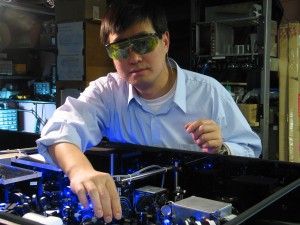New atomic clock loses only a second every 300 million years

The quest to create the perfect scientific timepiece has led to the development of an atomic clock that researchers from JILA claim to be fifty percent more accurate than results reported last year.
JILA, is a joint institute of the National Institute of Standards and Technology (NIST) and the University of Colorado (CU) at Boulder.
The international team, which included Jan W. Thomsen, a nuclear physicist and visiting professor from the Niels Bohr Institute in Denmark, applied new techniques that resulted in an enhanced strontium atomic clock that would neither gain nor lose one second in more than 300 million years.
This level of accuracy leapfrogs that of the current version of NIST-F1, a cesium fountain atomic clock that neither gains nor loses a second in about 80 million years and serves as the U.S. civilian time and frequency standard.
While some are billing JILA's clock as the world's most accurate, in mid-2006, the NIST announced an atomic clock based on a single mercury atom that would neither gain nor lose a second in about 400 million years.
In any case, atomic clocks have been around since the dawn of the atomic age and their accuracy has been increasing by a factor of 10 every decade and they're used to make the most precise calculations in physics and, increasingly, astronomy.
So how did the team at JILA boost the clocks accuracy? According to a press release from the NIST, the physicists had to get a grip on colliding fermions (i.e. collection of identical strontium atoms), which are used for the new breed of atomic clocks because they are not supposed to interact according to the theory of physics of quantum mechanics. Yet they did, as it turned out, and the researchers started to measure and control the 'seemingly forbidden collisions' between neutral strontium atoms.
Another press release adds color to the process :
It was an fascinating journey into the world of quantum mechanics. We found out that not all fermions were the same. At the very low temperatures the fermions begin to 'see' each other and interact and then the atomic clock begins to go awry", explains Jan W. Thomsen. The experiments showed that the fermion's quantum properties were being affected by the exposure to light itself and this lead to the loss of precision in the atomic clock. By tuning the light frequency in a certain way one could control the fermions and avoid the loss of precision.
The result is one of the world's most accurate devices for measuring scientific time. But according to the NIST, the research yields additional benefits: "The high precision of JILA's strontium lattice experimental setup is expected to be useful in other applications requiring exquisite control of atoms, such as quantum computing—potentially ultra-powerful computers based on quantum physics—and simulations to improve understanding of other quantum phenomena such as superconductivity."
